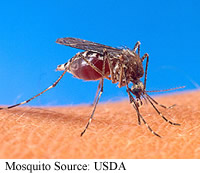 |
||||||||||||
 |
||||||||||||
 Insect
Control:
Insect
Control:
Aerial sprayings in urban areas is commonly conducted to reduce levels
for certain pests or to contain disease-carrying insects. There are many
chemicals used in urban insect control. Sometimes these chemicals are
harmful to humans.
The use of chemical pesticide DDT was widely used in urban aerial sprays to control urban mosquito, gypsy moths, Japanese beetle and other insects in the 1940’s. By 1972, DDT was banned from the United States due to widespread development of resistance to DDT and evidence that DDT use was increasing preterm births and also harming the environment.
Today, there are more than 500 species of insects and mites that are resistant to some form of pesticides. As a result of the increasing resistance, countries have started to apply more products, combine pesticides, increase applications, or substitute with more toxic replacements.
Safety with Bt urban areial spraying
 Bt
has been found through rigorous testing to be harmless to humans, other
mammals, fish, birds, or basically all vertebrates. Many countries in
the world have incorporated Bt aerial spraying into their pest
control program. Bt products are used on millions of acres of
wooded areas and agricultural crops. These spays are used to control for
gypsy moths, blackflies, mosquitoes, and many other pests in forestry
and urban areas.
Bt
has been found through rigorous testing to be harmless to humans, other
mammals, fish, birds, or basically all vertebrates. Many countries in
the world have incorporated Bt aerial spraying into their pest
control program. Bt products are used on millions of acres of
wooded areas and agricultural crops. These spays are used to control for
gypsy moths, blackflies, mosquitoes, and many other pests in forestry
and urban areas.
Tests conducted during spraying over urban areas in Canada and the US
showed no negative effects on humans. There was no correlation between
the aerial application of Bt and the short-term health effects
in the adult population, or in aggravation of asthma symptoms in children.